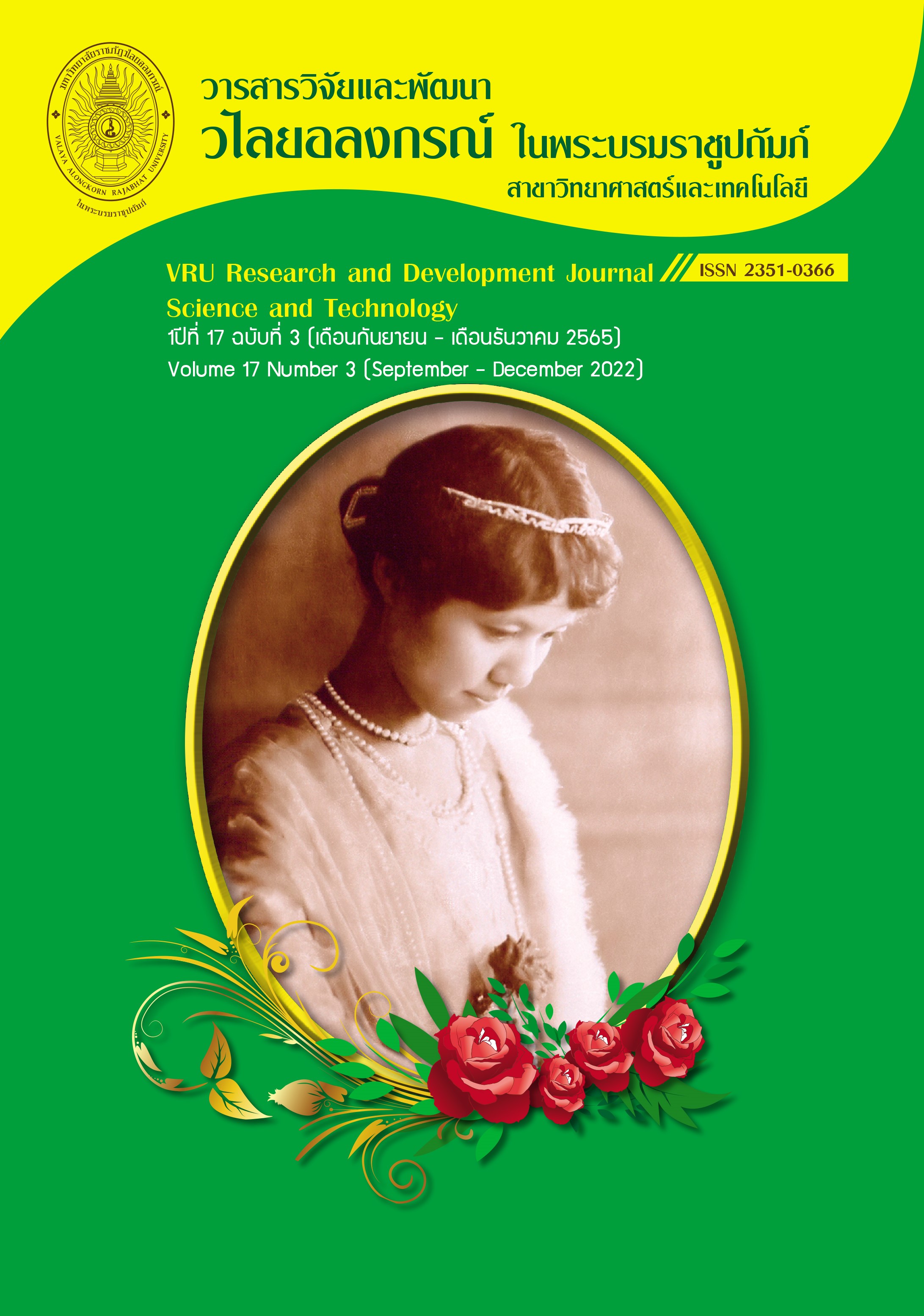TOTAL PHENOLIC CONTENT, TOTAL FLAVONOIDS CONTENT, ANTIOXIDANT ACTIVITY AND ALPHA GLUCOSIDASE INHIBITORY ACTIVITIES OF ETHANOLIC EXTRACT OF BORASSUS FLABELLIFER L. MALE FLOWERS
Main Article Content
Abstract
This research aimed to screen the phytochemical, total phenolic content, total flavonoid content, antioxidant activity and anti α-glucosidase activity of ethanolic extract of Borassus flabellifer L. male flowers. The Inhibition of the enzyme α-glucosidase was used to maintain post-meal blood glucose levels in diabetes mellitus type 2 patients. The results showed that the phytochemical screening of ethanolic extract of Borassus flabellifer L. male flowers were flavonoids, coumarins, saponins and terpenoids. The extracts showed the total phenolic contents and total flavonoid contents of 386.07±11.16 mgGAE/gextract and 637.63±21.28 mgQE/gextract, respectively. The antioxidant activity of ethanolic extract of Borassus flabellifer L. showed the IC50 values of 0.039±0.005 mg/mL. The extract was not statistically significant difference from butylated hydroxytoluene at the 95% confidence level. The results of anti-glucosidase activity, maltase and sucrase, showed the IC50 values of 218.48±0.55 and 286.49±0.09 µg/mL, respectively. In conclusion, the ethanolic extract of Borassus flabellifer L. male flowers can be used as a natural source of antioxidants and it can be developed as an alternative supplementary to control blood sugar levels.
Downloads
Article Details
Copyright Notice
The copyright of research articles published in the VRU Research and Development Journal Science and Technology Journal belongs to the Research and Development Institute, Valaya Alongkorn Rajabhat University under the Royal Patronage. Reproduction of the content, in whole or in part, is prohibited without prior written permission from the university.
Responsibility
The content published in the VRU Research and Development Journal Science and Technology Journal is the sole responsibility of the author(s). The journal does not assume responsibility for errors arising from the printing process.
References
Abdel-Hameed, E. S. (2009). Total phenolic contents and free radical scavenging activity of certain Egyptian Ficus species leaf samples. Food Chemistry, 114, 1271–1277.
Arirudran, B., Raja, A. V., Kumar, G., Anbarasu, K. & Shalini, E. (2022). Antimicrobial activity of Borassus flabellifer L. Root. HSOA Journal of Biotech Research & Biochemistry,
, 013.
Barrera, G. (2012). Oxidative stress and lipid peroxidation products in cancer progression and therapy. ISRN Oncology, 2012, 1-21.
Dos Santos, C. H., Borges, I. P., da Silva, V. C., de Sousa, P. T. Jr., Kawashita, N. H., Baviera, A. M. & Carvalho, M. G. (2016). A new dammarane saponin and other triterpenoids from Siolmatra brasiliensis and evaluation of the antidiabetic activity of its extract. Pharmaceutical Biology, 54(9), 1539-1547.
Harborne, J. B. (1998). Phytochemical Methods. A Guide to Modern Techniques of Plant Analysis. (3rd edition). London: Chapman & Hall.
Kavatagimath, S. A., Jalalpure, S. S. & Hiremath, R. D. (2016). Screening of Ethanolic Extract of Borassus flabellifer Flowers for its Antidiabetic and Antioxidant Potential. Journal of naturral remedies, 16(1), 22-32.
Khongkarat, P., Ramadhan, R., Phuwapraisirisan, P. & Chanchao, C. (2020). Safflospermidines from the bee pollen of Helianthus annuus L. exhibit a higher in vitro anti-tyrosinase activity than kojic acid. Heliyon, 6(3), e03638.
Marghitas, L. A., Stanciu, O. G., Dezmirean, D. S., Bobis, O., Popescu, O., Bogdanov, S. & Campos, M. G. (2009). In vitro antioxidant capacity of honeybee-collected pollen of selected floral origin harvested from Romania. Food Chemistry, 115(3), 878–883.
Maritim, A. C., Sanders, R. A. & Watkins, J. B. (2003). Diabetes, oxidative stress, and antioxidants: a review. Journal of Biochemical and Molecular Toxicology, 17(1), 24-38.
Naguleswaran, S., Vasanthan, T., Hoover, R. & Liu, Q. (2010). Structure and physicochemical properties of palmyrah (Borassus flabellifer L.) seed-shoot starch grown in Sri Lanka. Food chemistry, 118, 634-640.
Nisha, R., Parthasarathi, G., Chandrakumar, M., Arunachalam, R. & Krishnaveni, T. R. S. (2022). Potential Review on Palmyra (Borassus flabellifer L.). Journal of Advanced Research, 21, 29–40.
Pourmorad, F., Hosseinimehr, S. J., & Shahabimajd, N. (2006). Antioxidant activity, phenol and flavonoid contents of some selected Iranian medicinal plants. African Journal of Biotechnology, 5(11), 1142-1145.
Ramadhan, R., Kusuma, I. W., Amirta, R., Worawalai, W. & Phuwapraisirisan, P. (2018). A new 4-arylflavan from the pericarps of Horsfieldia motleyi displaying dual inhibition against α-glucosidase and free radicals. Natural Product Research, 32(22), 2676-2682.
Rani, R., Arora, S., Kaur, J. & Manhas, R. K. (2018). Phenolic compounds as antioxidants and chemopreventive drugs from Streptomyces cellulosae strain TES17 isolated from rhizosphere of Camellia sinensis. BMC Complementary and Alternative Medicine, 18,82.
Renuka, K., Devi, V. R. & Subramanian, S. P. (2018). Phytochemical screening and evaluation of in vitro antioxidant potential of immature palmyra palm Borassus flabellifer L. fruits. International Journal of Pharmacy and Pharmaceutical Sciences, 10(8), 77-83.
Sassi, A. B., Amroussi, S., Besbes, M., Aouni, M., & Skhiri, F. (2018). Antioxidant and α-glucosidase activities and phytochemical constituents of Chrysanthoglossum trifurcatum (Desf.). Asian Pacific Journal of Tropical Medicine, 11(4), 285-291.
Sheen, Y.J. & Sheu, W. H. H. (2016). Association between hypoglycemia and dementia in patients with type 2 diabetes. Diabetes Research and Clinical Practice. 116, 279-287.
Simsek, M., Quezada-Calvillo, R., Nichols, B. L. & Hamaker B.R. (2017). Phenolic compounds increase the transcription of mouse intestinal maltase-glucoamylase and sucrase-isomaltase. Food & Function journal, 8, 1915–1924.
Singchai, B., Kansane, K. & Chourykaew, B. (2015). Phytochemical screening and biological activities of Borassus flabellifer L. Asian Journal of Pharmaceutical and Clinical Research, 8(3), 151-153.
Singh, S., Farswan, M., Ali, S., Afzal, M., Al-Abbasi, F. A., Kazmi, I. & Anwar, F. (2014). Antidiabetic potential of triterpenoid saponin isolated from Primula denticulate. Pharmaceutical Biology, 52(6), 750-755.
Teh, S. S., Bekhit, A. E. D. & Birch, J. (2014). Antioxidative polyphenols from defatted oil seed cakes: effect of solvent. Antioxidants, 3(1), 67-80.
Verpoorte, R. (2012). Good practices: the basis for evidence-based medicines. Journal of Ethnopharmacology, 140(3), 455-457.
Yin, Z., Zhang, W., Feng, F., Zhang, Y., & Kang, W. (2014). α-Glucosidase inhibitors isolated from medicinal plants. Food Science and Human Wellness, 3(3–4), 136-174.


